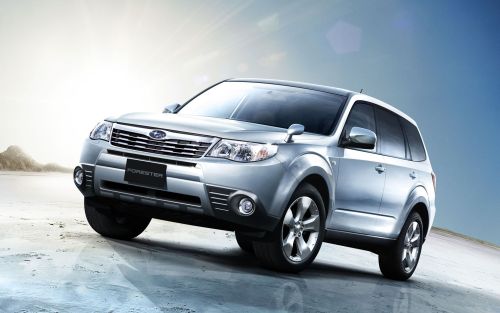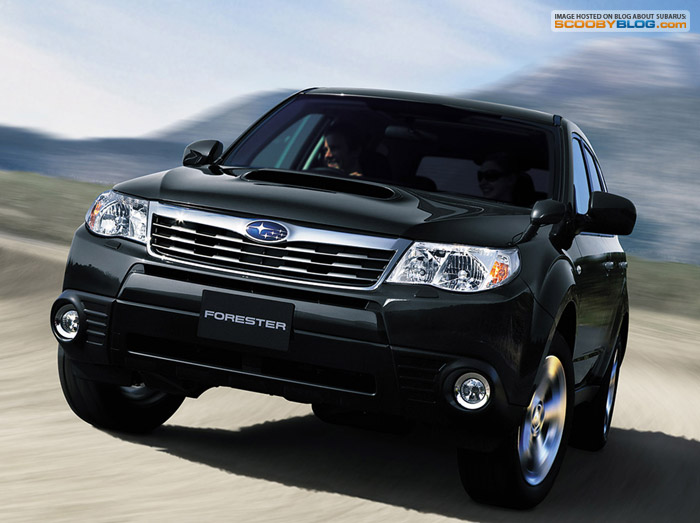
If you were hoping to see an all-new wrapper announce the arrival of this reworked engine, Subaru has news for you. It ain’t happening. The third-generation Forester debuted in 2008, and the vehicle’s face and roomy proportions are still quite fresh. To that end, there’s little to distinguish the 2011 model from its 2010 counterpart. Up front, the grille and swept headlights work together to create a cohesive look that draws your eye down the side of the vehicle. Details like large insets for fog lights, flared fenders and boxy side-view mirrors help give the Forester more of an SUV flavor than other compact high-riders out there, and while we miss some of the wagon aspects of older Foresters, we have to say this look is plenty becoming, especially when lined up against some of the other designs in the Subaru stable.
Inside, the story is much the same. Hordes of hard, yet well-grained plastics still abound, and while the decorative swath of silver trim helps to brighten the cabin, the cockpit is still a little dark for our tastes. The driver is treated to a well-sorted steering wheel with controls for cruise, hands-free calling and the stereo within reach, and the set of somewhat plain gauges are easy to read day or night. Things become a little muddled in the center stack, however. Our tester came with the optional TomTom navigation system, and its fitment looks aftermarket at best.
While most everything is well situated and logically laid out indoors, we did have to scratch our heads a bit over the placement of the switches for the heated seats. Located under the arm rest and on the driver’s side of the cupholder, passengers have no chance of finding the controls without instruction. While it makes for hilarious bun-warming practical jokes from the driver, a more centrally-situated location would be more user-friendly.
Of course, all of that could easily be said about the 2010 model. The real difference here lurks under the hood. Despite the deceptively similar numbers compared to last year’s model, the 2011 Forester uses an engine that’s considerably more advanced than its predecessor. The old engine’s belt-driven, single-overhead cam design has been replaced with a chain-driven dual-overhead cam setup for better efficiency. The change helped net the engine an extra one mpg in the city on the EPA’s cycle. Additionally, the four-cylinder uses a marginally larger bore and longer stroke, tweaking displacement from 2,457cc to 2,498cc and helping to deliver an extra four pound-feet of torque 300 rpm sooner than the old 2.5-liter engine.
Unfortunately, the new engine is still bolted to the same four-speed automatic transmission that Moses brought down from Mount Fuji. As a result, the new 2.5-liter feels very similar to the old one in terms of acceleration. The slight bump in torque is barely apparent low in the rev band, and the engine still runs out of breath on the deep end of the tachometer. Still, that’s not to say that the four-cylinder is identical to its predecessor. The engine is significantly quieter and a galaxy smoother than the last generation boxer four-cylinder. Whereas the 2010 Forester was saddled with the company’s characteristically tractor-esque rumble from under the rounded hood, the 2011 hums along with a fraction of the racket. To us, the improvement would have been worth building five factories to accomplish.
Otherwise, miraculously little has changed from last year’s model to 2011. The Forester still provides hilariously excellent driving dynamics given its lofty ride height thanks to a pile of DNA borrowed from the lovable WRX. Compared to metal like the Honda CR-V and Toyota RAV-4, the Forester is a grin-maker through any series of twists. Just make sure the groceries are tied down in the rear.
During our week with the Forester, we saw an average of 23.4 mpg in mild-to-aggressive combined driving, landing just a glimmer north of the EPA’s 21 mpg city and 27 mpg highway rating. While the Forester 2.5X Premium carries an MSRP of $23,495, our tester came equipped with the $1,095 option package that throws in the TomTom navigation system, heated front seats and windshield wiper de-icer. The archaic four-speed automatic transmission adds another $1,000 to the recipe, and a $725 destination charge brought our final figure to $26,315.
We’ve had a soft-spot for the Forester since the first generation debuted in 1998, and while we would have liked the third-generation boxer engine bring to bring a little more to the table, the quieter, smoother mill makes for a more pleasant driving experience altogether. For us, the five-speed manual transmission is the logical solution to the old four-speed automatic, at least until Subaru can come up with an automatic gearbox to keep pace with its new engine architecture. With its surprising poise, copious cargo room and ample passenger space, the Forester still makes an excellent alternative to hordes of Novocain CUVs out there.
If you are a huge fan of Subaru's SUV, the Forester, and live in North America, you will be glad to hear that Subaru is giving a little power upgrade to its 2011 Forester :
All-new engine for Forester 2.5X models (turbocharged 2.5XT retains current engine); new bore/stroke dimensions with slightly longer stroke; displacement slightly larger (2,498 cc vs. 2,457 cc); chain driven double overhead cam vs. belt driven single overhead cam before; 170 horsepower is same as before, at slightly lower rpm; torque is up to 174 lb.-ft. at 4,100 rpm (vs. 170 @ 4,400 rpm); fuel economy is improved: 2011 manual and automatic transmissions -- 21 mpg city / 27 mpg highway vs. 2010 20/27 for manual and 20/26 for automatic.
New 2.5X Touring positioned above Limited: features HID headlights (low beam) with automatic height adjustment; display audio system with backup camera; dual zone automatic climate control; silver finish roof rails; electroluminescent gauges, and side mirrors with integrated turn signals.
2.5XT models now include 2.5XT Premium and 2.5XT Touring, the latter replacing 2.5XT Limited as top Forester model.
2.5XT Premium gets new 10-way power driver’s seat.
Bluetooth® standard on all but base model.
Backup camera standard on 2.5X Touring and 2.5XT Touring as part of new audio system.
New standard audio system for 2.5X Premium and 2.5XT Premium: AM/FM stereo with single-disc CD player and six speakers; 3.5mm auxiliary input jack; Bluetooth® hands free calling and audio streaming; iPod control capability; USB port and Sirius Satellite Radio capability.
New optional TomTom Navigation System for 2.5X Premium includes removable 4.3-inch touch-screen portable navigation device; AM/FM stereo with single-disc CD/DVD player and six speakers; 3.5mm auxiliary input jack; Bluetooth hands free calling; iPod control capability and USB port. Also, a backup camera is available as an accessory with this system.
New audio system with rear camera for 2.5X Limited and Touring and 2.5XT Touring models: AM/FM stereo with single-disc CD/DVD player and six speakers; 4.3-inch display screen, Radio Broadcast Data System; 3.5mm auxiliary input jack; Bluetooth hands free calling and audio streaming; iPod control capability; USB port and Sirius Satellite Radio capability. (The backup camera is standard on 2.5X Touring and 2.5XT Touring and available as an accessory for 2.5X Limited.)
All-new engine for Forester 2.5X models (turbocharged 2.5XT retains current engine); new bore/stroke dimensions with slightly longer stroke; displacement slightly larger (2,498 cc vs. 2,457 cc); chain driven double overhead cam vs. belt driven single overhead cam before; 170 horsepower is same as before, at slightly lower rpm; torque is up to 174 lb.-ft. at 4,100 rpm (vs. 170 @ 4,400 rpm); fuel economy is improved: 2011 manual and automatic transmissions -- 21 mpg city / 27 mpg highway vs. 2010 20/27 for manual and 20/26 for automatic.
New 2.5X Touring positioned above Limited: features HID headlights (low beam) with automatic height adjustment; display audio system with backup camera; dual zone automatic climate control; silver finish roof rails; electroluminescent gauges, and side mirrors with integrated turn signals.
2.5XT models now include 2.5XT Premium and 2.5XT Touring, the latter replacing 2.5XT Limited as top Forester model.
2.5XT Premium gets new 10-way power driver’s seat.
Bluetooth® standard on all but base model.
Backup camera standard on 2.5X Touring and 2.5XT Touring as part of new audio system.
New standard audio system for 2.5X Premium and 2.5XT Premium: AM/FM stereo with single-disc CD player and six speakers; 3.5mm auxiliary input jack; Bluetooth® hands free calling and audio streaming; iPod control capability; USB port and Sirius Satellite Radio capability.
New optional TomTom Navigation System for 2.5X Premium includes removable 4.3-inch touch-screen portable navigation device; AM/FM stereo with single-disc CD/DVD player and six speakers; 3.5mm auxiliary input jack; Bluetooth hands free calling; iPod control capability and USB port. Also, a backup camera is available as an accessory with this system.
New audio system with rear camera for 2.5X Limited and Touring and 2.5XT Touring models: AM/FM stereo with single-disc CD/DVD player and six speakers; 4.3-inch display screen, Radio Broadcast Data System; 3.5mm auxiliary input jack; Bluetooth hands free calling and audio streaming; iPod control capability; USB port and Sirius Satellite Radio capability. (The backup camera is standard on 2.5X Touring and 2.5XT Touring and available as an accessory for 2.5X Limited.)
















